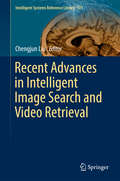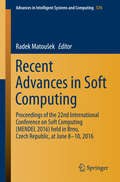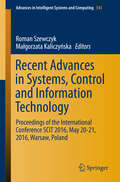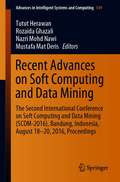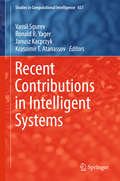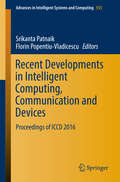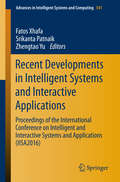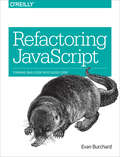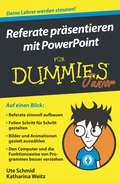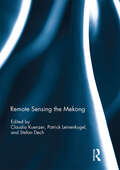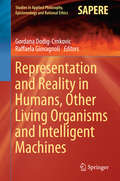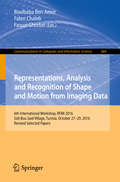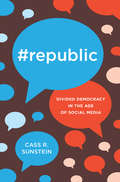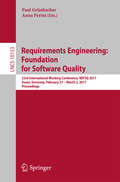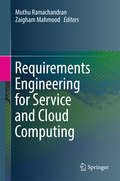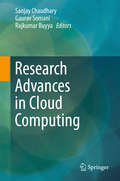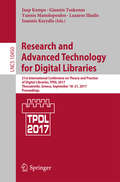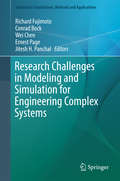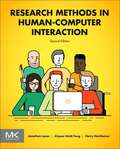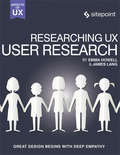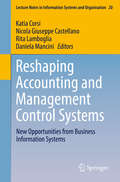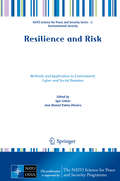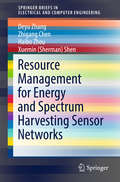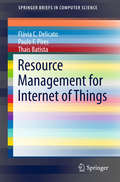- Table View
- List View
Recent Advances in Intelligent Image Search and Video Retrieval
by Chengjun LiuThis book initially reviews the major feature representation and extraction methods and effective learning and recognition approaches, which have broad applications in the context of intelligent image search and video retrieval. It subsequently presents novel methods, such as improved soft assignment coding, Inheritable Color Space (InCS) and the Generalized InCS framework, the sparse kernel manifold learner method, the efficient Support Vector Machine (eSVM), and the Scale-Invariant Feature Transform (SIFT) features in multiple color spaces. Lastly, the book presents clothing analysis for subject identification and retrieval, and performance evaluation methods of video analytics for traffic monitoring. Digital images and videos are proliferating at an amazing speed in the fields of science, engineering and technology, media and entertainment. With the huge accumulation of such data, keyword searches and manual annotation schemes may no longer be able to meet the practical demand for retrieving relevant content from images and videos, a challenge this book addresses. This book initially reviews the major feature representation and extraction methods and effective learning and recognition approaches, which have broad applications in the context of intelligent image search and video retrieval. It subsequently presents novel methods, such as improved soft assignment coding, Inheritable Color Space (InCS) and the Generalized InCS framework, the sparse kernel manifold learner method, the efficient Support Vector Machine (eSVM), and the Scale-Invariant Feature Transform (SIFT) features in multiple color spaces. Lastly, the book presents clothing analysis for subject identification and retrieval, and performance evaluation methods of video analytics for traffic monitoring. Digital images and videos are proliferating at an amazing speed in the fields of science, engineering and technology, media and entertainment. With the huge accumulation of such data, keyword searches and manual annotation schemes may no longer be able to meet the practical demand for retrieving relevant content from images and videos, a challenge this book addresses.
Recent Advances in Soft Computing
by Radek MatoušekThis proceeding book contains a collection of selected accepted papers of the Mendel conference held in Brno, Czech Republic in June 2016. The proceedings book contains three chapters which present recent advances in soft computing including intelligent image processing. The Mendel conference was established in 1995 and is named after the scientist and Augustinian priest Gregor J. Mendel who discovered the famous Laws of Heredity. The main aim of the conference is to create a regular possibility for students, academics and researchers to exchange ideas and novel research methods on a yearly basis.
Recent Advances in Systems, Control and Information Technology
by Roman Szewczyk Małgorzata KaliczyńskaThis book presents the proceedings of the International Conference on Systems, Control and Information Technologies 2016. It includes research findings from leading experts in the fields connected with INDUSTRY 4. 0 and its implementation, especially: intelligent systems, advanced control, information technologies, industrial automation, robotics, intelligent sensors, metrology and new materials. Each chapter offers an analysis of a specific technical problem followed by a numerical analysis and simulation as well as the implementation for the solution of a real-world problem.
Recent Advances on Soft Computing and Data Mining
by Mustafa Mat Deris Nazri Mohd Nawi Rozaida Ghazali Tutut HerawanThis book provides a comprehensive introduction and practical look at the concepts and techniques readers need to get the most out of their data in real-world, large-scale data mining projects. It also guides readers through the data-analytic thinking necessary for extracting useful knowledge and business value from the data. The book is based on the Soft Computing and Data Mining (SCDM-16) conference, which was held in Bandung, Indonesia on August 18th-20th 2016 to discuss the state of the art in soft computing techniques, and offer participants sufficient knowledge to tackle a wide range of complex systems. The scope of the conference is reflected in the book, which presents a balance of soft computing techniques and data mining approaches. The two constituents are introduced to the reader systematically and brought together using different combinations of applications and practices. It offers engineers, data analysts, practitioners, scientists and managers the insights into the concepts, tools and techniques employed, and as such enables them to better understand the design choice and options of soft computing techniques and data mining approaches that are necessary to thrive in this data-driven ecosystem.
Recent Advances on Soft Computing and Data Mining: The Second International Conference on Soft Computing and Data Mining (SCDM-2016), Bandung, Indonesia, August 18-20, 2016 Proceedings (Advances in Intelligent Systems and Computing #549)
by Tutut Herawan Rozaida Ghazali Nazri Mohd Nawi Mustafa Mat DerisThis book provides a comprehensive introduction and practical look at the concepts and techniques readers need to get the most out of their data in real-world, large-scale data mining projects. It also guides readers through the data-analytic thinking necessary for extracting useful knowledge and business value from the data.The book is based on the Soft Computing and Data Mining (SCDM-16) conference, which was held in Bandung, Indonesia on August 18th–20th 2016 to discuss the state of the art in soft computing techniques, and offer participants sufficient knowledge to tackle a wide range of complex systems. The scope of the conference is reflected in the book, which presents a balance of soft computing techniques and data mining approaches. The two constituents are introduced to the reader systematically and brought together using different combinations of applications and practices. It offers engineers, data analysts, practitioners, scientists and managers the insights into the concepts, tools and techniques employed, and as such enables them to better understand the design choice and options of soft computing techniques and data mining approaches that are necessary to thrive in this data-driven ecosystem.
Recent Contributions in Intelligent Systems
by Vassil Sgurev Ronald R. Yager Janusz Kacprzyk Krassimir T. AtanassovThis volume is a brief, yet comprehensive account of new development, tools, techniques and solutions in the broadly perceived "intelligent systems". New concepts and ideas concern the development of effective and efficient models which would make it possible to effectively and efficiently describe and solve processes in various areas of science and technology. Special emphasis is on the dealing with uncertainty and imprecision that permeates virtually all real world processes and phenomena, and has to properly be modeled by formal and algorithmic tools and techniques so that they be adequate and useful. The papers in this volume concern a wide array of possible techniques exemplified by, on the one hand, logic, probabilistic, fuzzy, intuitionistic fuzzy, neuro-fuzzy, etc. approaches. On the other hand, they represent the use of such systems modeling tools as generalized nets, optimization and control models, systems analytic models, etc. They concerns a variety of approaches, from pattern recognition, image analysis, education system modeling, biological and medical systems modeling, etc.
Recent Developments in Intelligent Computing, Communication and Devices
by Srikanta Patnaik Florin Popentiu-VladicescuThe book presents high quality papers presented at 2nd International Conference on Intelligent Computing, Communication & Devices (ICCD 2016) organized by Interscience Institute of Management and Technology (IIMT), Bhubaneswar, Odisha, India, during 13 and 14 August, 2016. The book covers all dimensions of intelligent sciences in its three tracks, namely, intelligent computing, intelligent communication and intelligent devices. intelligent computing track covers areas such as intelligent and distributed computing, intelligent grid and cloud computing, internet of things, soft computing and engineering applications, data mining and knowledge discovery, semantic and web technology, hybrid systems, agent computing, bioinformatics, and recommendation systems. Intelligent communication covers communication and network technologies, including mobile broadband and all optical networks that are the key to groundbreaking inventions of intelligent communication technologies. This covers communication hardware, software and networked intelligence, mobile technologies, machine-to-machine communication networks, speech and natural language processing, routing techniques and network analytics, wireless ad hoc and sensor networks, communications and information security, signal, image and video processing, network management, and traffic engineering. And finally, the third track intelligent device deals with any equipment, instrument, or machine that has its own computing capability. As computing technology becomes more advanced and less expensive, it can be built into an increasing number of devices of all kinds. The intelligent device covers areas such as embedded systems, RFID, RF MEMS, VLSI design and electronic devices, analog and mixed-signal IC design and testing, MEMS and microsystems, solar cells and photonics, nanodevices, single electron and spintronics devices, space electronics, and intelligent robotics.
Recent Developments in Intelligent Systems and Interactive Applications
by Fatos Xhafa Srikanta Patnaik Zhengtao YuThis book provides the latest research findings and developments in the field of interactive intelligent systems, addressing diverse areas such as autonomous systems, Internet and cloud computing, pattern recognition and vision systems, mobile computing and intelligent networking, and e-enabled systems. It gathers selected papers from the International Conference on Intelligent and Interactive Systems and Applications (IISA2016) held on June 25-26, 2016 in Shanghai, China. Interactive intelligent systems are among the most important multi-disciplinary research and development domains of artificial intelligence, human-computer interaction, machine learning and new Internet-based technologies. Accordingly, these systems embrace a considerable number of application areas such as autonomous systems, expert systems, mobile systems, recommender systems, knowledge-based and semantic web-based systems, virtual communication environments, and decision support systems, to name a few.
Refactoring JavaScript: Turning Bad Code Into Good Code
by Evan BurchardHow often do you hear people say things like this? "Our JavaScript is a mess, but we’re thinking about using [framework of the month]."Like it or not, JavaScript is not going away. No matter what framework or ”compiles-to-js” language or library you use, bugs and performance concerns will always be an issue if the underlying quality of your JavaScript is poor. Rewrites, including porting to the framework of the month, are terribly expensive and unpredictable. The bugs won’t magically go away, and can happily reproduce themselves in a new context. To complicate things further, features will get dropped, at least temporarily.The other popular method of fixing your JS is playing “JavaScript Jenga,” where each developer slowly and carefully takes their best guess at how the out-of-control system can be altered to allow for new features, hoping that this doesn’t bring the whole stack of blocks down. This book provides clear guidance on how best to avoid these pathological approaches to writing JavaScript:Recognize you have a problem with your JavaScript quality.Forgive the code you have now, and the developers who made it.Learn repeatable, memorable, and time-saving refactoring techniques.Apply these techniques as you work, fixing things along the way.Internalize these techniques, and avoid writing as much problematic code to begin with.Bad code doesn’t have to stay that way. And making it better doesn’t have to be intimidating or unreasonably expensive.
Referate präsentieren mit PowerPoint für Dummies Junior (Für Dummies)
by Ute Schmid Katharina WeitzDu sollst ein Referat in der Schule halten und willst es richtig gut machen? Du hast schon mal in PowerPoint hineingeschaut, weißt aber nicht so genau, was man dort alles so machen kann? Du möchtest gern verstehen, wie der Computer arbeitet? Dann ist dieses Buch genau richtig für dich. Gestalte übersichtliche Folien, sodass dein Publikum schnell versteht, worum es geht. Wähle ein Design, erstelle Notizen, füge Bilder, Tabellen und Animationen ein. Finde heraus, wie Anwendersoftware aufgebaut ist und was du davon erwarten kannst. Bestens geeignet für Kinder und Jugendliche ab 10 Jahre. Du wirst von diesen Tipps und Techniken begeistert sein.
Remote Sensing the Mekong
by Claudia Kuenzer Patrick Leinenkugel Stefan DechThe Mekong Basin in Southeast Asia is one of the largest international river basins in the world. Its abundant natural resources are shared by six riparian countries and provide the basis for the livelihoods of more than 75 million people. However, ongoing socio-economic growth and related anthropogenic interventions impact the region’s ecosystems, and there is an urgent need for the monitoring of the basin's land surface dynamics. Remote sensing has evolved as a key tool for this task, allowing for up-to-date analyses and regular monitoring of environmental dynamics beyond physical or political boundaries and at various temporal and spatial scales. This book serves as a forum for remote-sensing scientists with an interest in the Mekong River Basin to present their recent basin-related works as well as applied case studies of the region. A broad range of sensors from high to medium resolution, and from multispectral to SAR systems, are applied, covering topics such as land cover/land use classification and comparison, time series analyses of climate variables, vegetation structure and vegetation productivity, as well as studies on flood mapping or water turbidity monitoring. This book was originally published as a special issue of the International Journal of Remote Sensing.
Representation and Reality in Humans, Other Living Organisms and Intelligent Machines (Studies in Applied Philosophy, Epistemology and Rational Ethics #28)
by Gordana Dodig-Crnkovic Raffaela GiovagnoliThis book enriches our views on representation and deepens our understanding of its different aspects. It arises out of several years of dialog between the editors and the authors, an interdisciplinary team of highly experienced researchers, and it reflects the best contemporary view of representation and reality in humans, other living beings, and intelligent machines. Structured into parts on the cognitive, computational, natural sciences, philosophical, logical, and machine perspectives, a theme of the field and the book is building and presenting networks, and the editors hope that the contributed chapters will spur understanding and collaboration between researchers in domains such as computer science, philosophy, logic, systems theory, engineering, psychology, sociology, anthropology, neuroscience, linguistics, and synthetic biology.
Representations, Analysis and Recognition of Shape and Motion from Imaging Data
by Boulbaba Ben Amor Faten Chaieb Faouzi GhorbelThis book constitutes the refereed proceedings of the 6th International Workshop on Representations, Analysis and Recognition of Shape and Motion from Imaging Data, RFMI 2016, held in Sidi Bou Said Village, Tunisia, in October 2016. The 9 revised full papers and 7 revised short papers presented were carefully reviewed and selected from 23 submissions. The papers are organized in topical sections on 3D Shape Registration and Comparison; Face Analysis and Recognition; Video and Motion Analysis; 2D Shape Analysis.
#Republic: Divided Democracy in the Age of Social Media
by Cass R. SunsteinAs the Internet grows more sophisticated, it is creating new threats to democracy. Social media companies such as Facebook can sort us ever more efficiently into groups of the like-minded, creating echo chambers that amplify our views. It's no accident that on some occasions, people of different political views cannot even understand each other. It's also no surprise that terrorist groups have been able to exploit social media to deadly effect.Welcome to the age of #Republic.In this revealing book, Cass Sunstein, the New York Times bestselling author of Nudge and The World According to Star Wars, shows how today's Internet is driving political fragmentation, polarization, and even extremism—and what can be done about it.Thoroughly rethinking the critical relationship between democracy and the Internet, Sunstein describes how the online world creates "cybercascades," exploits "confirmation bias," and assists "polarization entrepreneurs." And he explains why online fragmentation endangers the shared conversations, experiences, and understandings that are the lifeblood of democracy.In response, Sunstein proposes practical and legal changes to make the Internet friendlier to democratic deliberation. These changes would get us out of our information cocoons by increasing the frequency of unchosen, unplanned encounters and exposing us to people, places, things, and ideas that we would never have picked for our Twitter feed.#Republic need not be an ironic term. As Sunstein shows, it can be a rallying cry for the kind of democracy that citizens of diverse societies most need.
Requirements Engineering: Foundation for Software Quality
by Paul Grünbacher Anna PeriniThis book constitutes the proceedings of the 23rd International Working Conference on Requirements Engineering - Foundation for Software Quality, REFSQ 2017, held in Essen, Germany, in February/March 2017. The 16 full papers and 10 short papers presented in this volume were carefully reviewed and selected from 77 submissions. The papers were organized in topical sections named: use case models; ecosystems and innovation; human factors in requirements engineering; goal-orientation in requirements engineering; communication and collaboration; process and tool integration; visualization and representation of requirements; agile requirements engineering; natural language processing, information retrieval and machine learning traceability; quality of natural language requirements; research methodology in requirements engineering.
Requirements Engineering for Service and Cloud Computing
by Muthu Ramachandran Zaigham MahmoodThis authoritative text/reference describes the state of the art in requirements engineering for software systems for distributed computing. A particular focus is placed on integrated solutions, which take into account the requirements of scalability, flexibility, sustainability and operability for distributed environments. Topics and features: discusses the latest developments, tools, technologies and trends in software requirements engineering; reviews the relevant theoretical frameworks, practical approaches and methodologies for service requirements; examines the three key components of the requirements engineering process, namely requirements elicitation, requirements specification, and requirements validation and evaluation; presents detailed contributions from an international selection of highly reputed experts in the field; offers guidance on best practices, and suggests directions for further research in the area.
Research Advances in Cloud Computing
by Sanjay Chaudhary Gaurav Somani Rajkumar BuyyaThis book addresses the emerging area of cloud computing, providing a comprehensive overview of the research areas, recent work and open research problems. The move to cloud computing is no longer merely a topic of discussion; it has become a core competency that every modern business needs to embrace and excel at. It has changed the way enterprise and internet computing is viewed, and this success story is the result of the long-term efforts of computing research community around the globe. It is predicted that by 2026 more than two-thirds of all enterprises across the globe will be entirely run in cloud. These predictions have led to huge levels of funding for research and development in cloud computing and related technologies. Accordingly, universities across the globe have incorporated cloud computing and its related technologies in their curriculum, and information technology (IT) organizations are accelerating their skill-set evolution in order to be better prepared to manage emerging technologies and public expectations of the cloud, such as new services.
Research and Advanced Technology for Digital Libraries: 21st International Conference on Theory and Practice of Digital Libraries, TPDL 2017, Thessaloniki, Greece, September 18-21, 2017, Proceedings (Lecture Notes in Computer Science #10450)
by Jaap Kamps, Giannis Tsakonas, Yannis Manolopoulos, Lazaros Iliadis and Ioannis KarydisThis book constitutes the proceedings of the 21st International Conference on Theory and Practice of Digital Libraries, TPDL 2017, held in Thessaloniki, Greece, in September 2017. The 39 full papers, 11 short papers, and 10 poster papers presented in this volume were carefully reviewed and selected from 106 submissions. In addition the book contains 7 doctoral consortium papers.The contributions are organized in topical sections named: linked data; corpora; data in digital libraries; quality in digital libraries; digital humanities; entities; scholarly communication; sentiment analysis; information behavior; information retrieval.
Research Challenges in Modeling and Simulation for Engineering Complex Systems (Simulation Foundations, Methods and Applications)
by Wei Chen Richard Fujimoto Conrad Bock Ernest Page Jitesh H. PanchalThis illuminating text/reference presents a review of the key aspects of the modeling and simulation (M&S) life cycle, and examines the challenges of M&S in different application areas. The authoritative work offers valuable perspectives on the future of research in M&S, and its role in engineering complex systems. Topics and features: reviews the challenges of M&S for urban infrastructure, healthcare delivery, automated vehicle manufacturing, deep space missions, and acquisitions enterprise; outlines research issues relating to conceptual modeling, covering the development of explicit and unambiguous models, communication and decision-making, and architecture and services; considers key computational challenges in the execution of simulation models, in order to best exploit emerging computing platforms and technologies; examines efforts to understand and manage uncertainty inherent in M&S processes, and how these can be unified under a consistent theoretical and philosophical foundation; discusses the reuse of models and simulations to accelerate the simulation model development process. This thought-provoking volume offers important insights for all researchers involved in modeling and simulation across the full spectrum of disciplines and applications, defining a common research agenda to support the entire M&S research community.
Research Methods In Human Computer Interaction
by Jonathan Lazar Jinjuan Heidi Feng Harry Hochheiser<P>Research Methods in Human-Computer Interaction is a comprehensive guide to performing research and is essential reading for both quantitative and qualitative methods.<P> Since the first edition was published in 2009, the book has been adopted for use at leading universities around the world, including Harvard University, Carnegie-Mellon University, the University of Washington, the University of Toronto, HiOA (Norway), KTH (Sweden), Tel Aviv University (Israel), and many others. <P>Chapters cover a broad range of topics relevant to the collection and analysis of HCI data, going beyond experimental design and surveys, to cover ethnography, diaries, physiological measurements, case studies, crowdsourcing, and other essential elements in the well-informed HCI researcher's toolkit.<P> Continual technological evolution has led to an explosion of new techniques and a need for this updated 2nd edition, to reflect the most recent research in the field and newer trends in research methodology.
Researching UX: User Research
by James Lang Emma HowellHow well do you really know your users? With properly conducted user research, you can discover what really makes your audience tick. This practical guide will show you, step-by-step, how to gain proper insight about your users so that you can base design decisions on solid evidence. You'll not only learn the different methodologies that you can employ in user research, but also gain insight into important set-up activities, such as recruiting users and equipping your lab, and acquire analysis skills so that you can make the most of the data you've gathered. And finally, you'll learn how to communicate findings and deploy evidence, to boost your design rationale and persuade skeptical colleagues. Design your researchCost justify user researchRecruit and incentivise usersDiscover how to run your research sessionsAnalyze your resultsReporting on results and acting in your findings
Reshaping Accounting and Management Control Systems
by Katia Corsi Nicola Giuseppe Castellano Rita Lamboglia Daniela ManciniThis book examines the relationship between digital innovations on the one hand, and accounting and management information systems on the other. In particular it addresses topics including cloud computing, data mining, XBRL, and digital platforms. It presents an analysis of how new technologies can reshape accounting and management information systems, enhancing their information potentialities and their ability to support decision-making processes, as well as several studies that reveal how managerial information needs can affect and reshape the adoption of digital technologies. Focusing on the four major aspects data management, information system architecture, external and internal reporting, the book offers a valuable resource for CIOs, CFOs and more generally for business managers, as well as for researchers and scholars. It is mainly based on a selection of the best papers - original double blind reviewed contributions - presented at the 2015 Annual Conference of the Italian Chapter of the Association for Information Systems (AIS).
Resilience and Risk
by Igor Linkov José Manuel Palma-OliveiraThis volume addresses the challenges associated with methodology and application of risk and resilience science and practice to address emerging threats in environmental, cyber, infrastructure and other domains. The book utilizes the collective expertise of scholars and experts in industry, government and academia in the new and emerging field of resilience in order to provide a more comprehensive and universal understanding of how resilience methodology can be applied in various disciplines and applications. This book advocates for a systems-driven view of resilience in applications ranging from cyber security to ecology to social action, and addresses resilience-based management in infrastructure, cyber, social domains and methodology and tools. Risk and Resilience has been written to open up a transparent dialog on resilience management for scientists and practitioners in all relevant academic disciplines and can be used as supplement in teaching risk assessment and management courses.
Resource Management for Energy and Spectrum Harvesting Sensor Networks
by Deyu Zhang Zhigang Chen Haibo Zhou Xuemin Sherman ShenThis SpringerBrief offers a comprehensive review and in-depth discussion of the current research on resource management. The authors explain how to best utilize harvested energy and temporally available licensed spectrum. Throughout the brief, the primary focus is energy and spectrum harvesting sensor networks (ESHNs) including energy harvesting (EH)-powered spectrum sensing and dynamic spectrum access. To efficiently collect data through the available licensed spectrum, this brief examines the joint management of energy and spectrum. An EH-powered spectrum sensing and management scheme for Heterogeneous Spectrum Harvesting Sensor Networks (HSHSNs) is presented in this brief. The scheme dynamically schedules the data sensing and spectrum access of sensors in ESHSNs to optimize the network utility, while considering the stochastic nature of EH process, PU activities and channel conditions. This brief also provides useful insights for the practical resource management scheme design for ESHSNs and motivates a new line of thinking for future sensor networking. Professionals, researchers, and advanced-level students in electrical or computer engineering will find the content valuable.
Resource Management for Internet of Things
by Flávia C. Delicato Paulo F. Pires Thais BatistaThis book investigates the pressing issue of resource management for Internet of Things (IoT). The unique IoT ecosystem poses new challenges and calls for unique and bespoke solutions to deal with these challenges. Using a holistic approach, the authors present a thorough study into the allocation of the resources available within IoT systems to accommodate application requirements. This is done by investigating different functionalities and architectural approaches involved in a basic workflow for managing the lifecycle of resources in an IoT system. Resource Management for the Internet of Things will be of interest to researchers and students as well as professional developers interested in studying the IoT paradigm from data acquisition to the delivery of value-added services for the end user.
